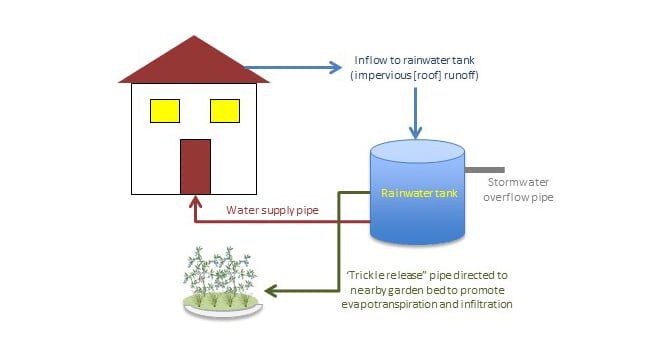
Figure 1: An allotment scale rainwater tank configured with a ‘trickle release’ pipe to release water at an equivalent rate to undeveloped catchment baseflows. Taken from Burns, Ladson and Fletcher (2015)
Urbanisation has a myriad of impacts on catchment hydrology and water quality that stress aquatic ecosystems. Critical refuge pools are lost or rendered less suitable for fish and other biota due to decreased baseflows and almost every time it rains, aquatic ecosystems are disturbed by poor quality urban runoff[1]. The aim is to mitigate these impacts effectively and efficiently to protect and restore aquatic ecosystems using technologies such as rainwater tanks. A recent cost-benefit analysis of rainwater tanks in South-East Queensland[2] concluded that the costs of mandating rainwater tanks in their catchments were greater than the benefits. However, the scope was limited and did not consider the multiple benefits of rainwater tanks on mitigating flow impacts and providing enhanced water security.
Rainwater tank benefits identified by Burns, Ladson and Fletcher (2015)[3] operate at small, repeated scales within catchments and include:
- Mimicking natural evapotranspiration losses. Urbanisation reduces evapotranspiration when water efficient native vegetation is replaced with gardens and lawns. Using tank water for toilet flushing and clothes washing before discharging into the sewer leads to losses equivalent to natural evapotranspiration in catchment water balances.
- Increasing infiltration and restoring lost baseflows – critical components of natural hydrographs. This is especially effective if an outlet pipe that is directed to local soils or the stormwater network is incorporated into the tank design (Figure 1). Ideally this outlet would release water at a rate that approximates baseflow for local, undeveloped catchments. Some water will reach the watercourse as filtered subsurface flows that will also contribute to groundwater recharge. Other water will reach the watercourse via the stormwater network as trickle rather than peak flows.
- Increasing initial loss and generating a rainfall-runoff response more like an undeveloped catchment. Where there is storage available, rainwater tanks can increase initial loss from ~0.5 mm (typical of hard surfaces) to about 20 mm (typical of undeveloped catchments). Ideally, the tanks will be designed for this purpose (e.g. large domestic tanks with multiple end-uses).
- Filtering and reducing overall pollutant loads from roof water. Sedimentation in the tank reduces suspended solids in overflow or trickle outflows. Microbes can be deactivated by storage, and biofilms in tanks perform numerous nutrient cycling processes.
Rainwater tanks used as part of an overall approach to ‘flow-regime management’2 reduce the hydraulic stress of urbanisation and restore natural flow components, which in turn, underpins Natural Resources Management (NRM) actions such as environmental water releases from reservoirs and on-ground works to improve habitats. They also contribute to pollutant and flow load-reduction whilst aligning with NRM outcomes as required by the targets and actions in the South Australian Water Sensitive Urban Design (WSUD) policy[4].
Rainwater tanks can retain large rainfall events, which can reduce flooding risk in small, urbanised catchments. Current work by the University of South Australia seeks to evaluate the effectiveness of WSUD measures, including retention and detention tanks, to ameliorate the impact of infill development on drainage system capacity. This feature will become more important over time given that climate change predictions show that intense peak rainfalls will be more common[5] and are likely to cause damage, if not at least partially retained.
Rainwater tanks are part of the solution. Other WSUD features, such as rain gardens and infiltration trenches could be used in combination with or instead of rainwater tanks in some developments. Rather than following the Queensland example of removing the need for rainwater tanks, perhaps greater flexibility in how water is retained and re-used on site could be incorporated into South Australian policy. That said, rainwater tanks are simple, cost-effective solutions that are readily accepted and can be easily used by the general public. If rainwater tanks are not used, then water needs to be retained elsewhere in the catchment, placing higher stress on municipal retention systems and potentially increasing the area of land required for alternative, offsite measures.
———————–
[1] Walsh CJ, Fletcher TD and Ladson ARr (2005) Stream restoration in urban catchments through re-designing stormwater systems: looking to the catchment to save the stream. Journal of the North American Benthological Society: 24(3): 690–705
[2] Marsden Jacob Associates (2012). Assessment of proposed repeal of water saving regulations. A report to the Queensland Competition Authority
[3] Burns, MJ, Ladson AR and TD Fletcher (2015) Impact of rainwater tanks on urban hydrology and stormwater quality. In Rainwater tanks systems for urban water supply: Design, yield, energy, health risks, economics and social perceptions. Editors: Sharma AK, Begbie D and Gardner T. IWA Publishing, London
[4] Water sensitive urban design: Creating more liveable and water sensitive cities in South Australia. Department of Environment, Water and Natural Resources.
[5] Wasko C and Sharma A (2015) Steeper temporal distribution of rain intensity at higher temperatures within Australian storms. Nature Geoscience: 8, pp. 527–529 (2015) doi:10.1038/ngeo2456





